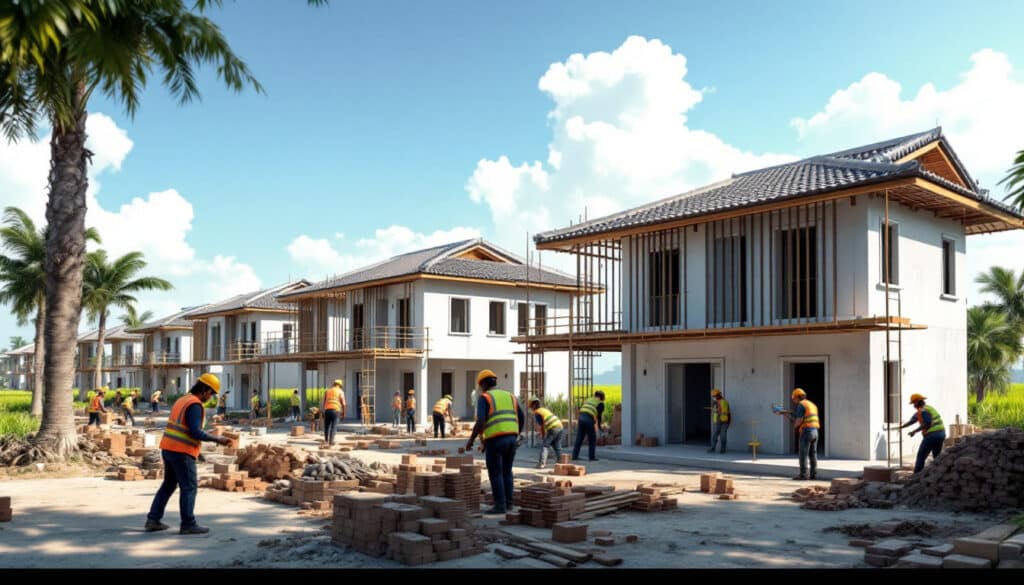The aviation is undergoing a silent revolution thanks to
additive manufacturing, a rapidly expanding technology.
This innovation promises to redefine the standards of the aerospace industry.
A systematic study of 29 open-access publications reveals the current state of additive manufacturing in the aviation sector. Researchers from the Universidade NOVA de Lisboa have highlighted the key benefits as well as the major obstacles hindering broader adoption. Among the notable benefits are the creation of lightweight structural parts and the optimization of decentralized supply chains. However, challenges persist, particularly regarding certification, costs, and process repeatability. The quality of materials and the variability of manufacturing parameters add additional complexity to the testing and qualification of components. Despite these obstacles, significant progress has been made in sustainable manufacturing, reducing material waste and improving energy efficiency. This bibliometric analysis directs future research priorities toward advanced simulation tools, qualification protocols, and the integration of AI and IoT for predictive maintenance.
The recognition of unified standards is crucial for the adoption of 3D printed components in critical flight systems. Rigorous benchmarking measures are necessary to evaluate the simulation and testing data of metallic components. Moreover, current validation methods are not fully suited to the layer-by-layer manufacturing processes unique to additive manufacturing. Concerns regarding material quality include porosity, surface finish, and residual stresses, especially for parts made by powder bed fusion. Although aluminum alloys are favored for their strength-to-weight ratio, they often require post-processing to meet aerospace standards.
Since the early UV resin systems in the 1980s, 3D printing technology has undergone rapid evolution. Charles Hull’s stereolithography marked the beginning of 3D printer commercialization in 1987, closely followed by selective laser sintering and fused filament deposition. Hybrid systems, combining CNC milling and directed energy processes, are also gaining ground. These technologies support a variety of materials, including metals, polymers, and ceramics, facilitating their integration into various aerospace components. Metal processes dominate the examined literature due to their relevance for structural parts.
Economic evaluations of additive manufacturing in aviation show mixed results. While some studies indicate cost savings of up to 33.2% in specific aerospace applications, others highlight increased expenditures related to machine acquisition, material costs, and post-processing. Most publications agree that additive manufacturing is currently better suited for low-volume, high-complexity components, where traditional tooling costs would be prohibitive. In contrast, environmental benefits are more consistent, with a reduction in material waste, fewer machining steps, and lower “buy-to-fly” ratios. However, these savings are heavily dependent on part geometry and life cycle design, which can be offset by energy-intensive post-processing.
The logistics of spare parts and aircraft maintenance are key use cases for additive manufacturing in aviation. Digital inventories and decentralized production can reduce lead times and eliminate the need for excessive storage, particularly for legacy aircraft whose parts are no longer manufactured. Simulation models demonstrate that decentralized manufacturing can reduce transportation needs and improve aircraft availability. Topological optimization and part consolidation are at the core of these advancements, allowing for the rethinking of components to reduce weight and enhance structural efficiency. These efforts support commercial aviation initiatives aimed at improving energy efficiency and reducing emissions, although success depends on workforce skills, software maturity, and real-time data access for maintenance workflows.
Future research directions focus on developing simulation tools, qualification protocols, and digital integration. It is essential to create process simulation tools, surface treatment methods for metals, and qualification protocols tailored to additive manufacturing. Specialized training is also emphasized to equip engineers with the skills necessary for design-for-AM. Furthermore, the integration of AI and IoT is crucial to support automated monitoring and predictive maintenance. While regulatory agencies such as EASA and FAA have organized workshops on certification for additive manufacturing, formal standards remain under development. The ISO/TC 261 is working on necessary documentation, but harmonization between global jurisdictions is still incomplete.
The aerospace industry stands at a technological crossroads where 3D printing, or additive manufacturing, promises to revolutionize how components are designed and produced. However, despite its obvious potential, a recent systematic literature review conducted by researchers Jorge Oliveira and Pedro Espadinha-Cruz from NOVA University Lisbon highlights several major obstacles hindering its large-scale adoption in this demanding sector.
Table of Contents
ToggleWhat are the main obstacles to the adoption of 3D printing in aerospace?
The adoption of 3D printing in aerospace is hindered by several technical and regulatory challenges. The first barrier is that the certification of 3D printed parts remains a major issue. In regulated sectors like aerospace, the absence of unified standards complicates the acceptance of components produced by additive methods. Without rigorous validation procedures, manufacturers are hesitant to integrate these new technologies into critical systems.
Another significant obstacle is the repeatability of additive manufacturing processes. Current methods, often based on layer-by-layer production, can lead to variations in material properties. This inconsistency poses problems for applications where reliability is essential, such as in the manufacturing of aerospace structural parts.
Finally, the quality of materials used in 3D printing is also a concern. Issues such as porosity, surface finish, and residual stresses compromise the performance of parts. Aluminum alloys, prized for their strength-to-weight ratio, often require costly post-treatments to meet the strict standards of the aerospace industry.
What are the advantages of 3D printing for the aerospace industry?
Despite these challenges, 3D printing offers undeniable advantages that can transform the aerospace industry. One of the most significant benefits is the ability to produce lightweight structural parts. Through innovative designs and topological optimizations, engineers can create lighter components while maintaining their structural integrity, thereby contributing to better energy efficiency of aircraft.
Moreover, 3D printing facilitates the establishment of decentralized supply chains. This allows for local production of spare parts, thereby reducing lead times and logistical costs. This decentralization is particularly beneficial for older aircraft requiring specific components whose traditional production has become costly or obsolete.
In terms of sustainable manufacturing, 3D printing is distinguished by a significant reduction in material waste. Additive methods optimize the use of raw materials, thereby decreasing the environmental footprint of aerospace production. For example, some studies show a 60% reduction in material consumption in metallic applications due to additive manufacturing.
How history and standards influence the adoption of 3D printing
The evolution of 3D printing technologies dates back to the 1980s with the first UV resin systems by Hideo Kodama. Since then, innovations such as Charles Hull’s stereolithography have led to the commercialization of 3D printers in 1987. Today, technologies like selective laser sintering and fused filament modeling dominate the market.
The classification of additive manufacturing technologies now follows the ISO/ASTM standards, including categories such as powder bed fusion, directed energy deposition, binder jetting, VAT photopolymerization, and material extrusion. These classifications help standardize processes, but global harmonization of standards remains incomplete, thus hindering the uniform adoption of technologies in as rigorous sectors as aerospace.
Hybrid systems, combining CNC milling and directed energy processes, are also gaining ground. These technologies enable the integration of various materials, including metals, polymers, and ceramics, offering increased flexibility in designing aerospace components.
Cost and sustainability analysis
The cost analysis of 3D printing in the aerospace industry reveals mixed results. Some studies indicate savings of up to 33.2% in specific applications due to reduced tooling and production costs. In contrast, other research highlights increased expenditures related to the acquisition of machines, specialized materials, and necessary post-treatments to meet required standards.
Nevertheless, 3D printing proves particularly cost-effective for the production of low-volume and high-complexity components, where traditional manufacturing methods become prohibitively expensive. This technology allows for reduced storage costs by producing parts on demand, thus eliminating the need to maintain a significant inventory of spare parts.
From a sustainability standpoint, 3D printing presents notable ecological advantages. The reduction of material waste and manufacturing steps contributes to a lower carbon footprint. For instance, reducing the “buy-to-fly” ratio can significantly decrease the consumption of materials in metals. However, these benefits are heavily dependent on the geometry of the parts and their lifecycle design, which can be offset by increased energy consumption during post-treatments.
Impact of 3D printing on spare parts and decentralized production
The impact of 3D printing on spare part logistics and decentralized production is considerable. Several studies show that additive manufacturing can transform inventory management by enabling the creation of digital inventories, thereby reducing lead times and avoiding the necessity of storing expensive or obsolete parts. This capability is particularly beneficial for older aircraft requiring specific components that traditional manufacturing methods can no longer provide effectively.
Additionally, 3D printing facilitates topological optimization and part consolidation. Engineers can redesign components to reduce their weight while improving their structural efficiency. This optimization plays a key role in ongoing efforts by aerospace to improve fuel consumption and reduce greenhouse gas emissions. However, the success of these initiatives depends on the availability of worker skills, software maturity, and real-time data access for maintenance workflows.
The future perspectives of research in aerospace 3D printing
Future research directions identified by the review highlight several key areas requiring in-depth exploration to foster the adoption of 3D printing in aerospace. The development of process simulation tools, qualification protocols, and surface treatment methods for metals is crucial. These technological advancements will improve the repeatability and quality of printed parts, thereby meeting the strict requirements of the industry.
Moreover, the integration of artificial intelligence (AI) and Internet of Things (IoT) is essential to support predictive maintenance and the automated monitoring of additive manufacturing processes. These technologies enable real-time monitoring, thus optimizing the performance and reliability of production systems.
Regulatory agencies such as the European Union Aviation Safety Agency (EASA) and the Federal Aviation Administration (FAA) play a crucial role in developing certification standards specific to 3D printing. While workshops and discussions are ongoing, formal standards remain at an early stage, requiring international harmonization for broader adoption.
For those interested in the future advancements of 3D printing in aerospace, resources such as characterization and valorization of coal or profitable 3D printing business ideas for 2025 provide innovative perspectives for shaping the future of this transformative technology.
Continuous progress in these areas will determine whether 3D printing can truly meet the complex needs of the aerospace industry, ensuring the necessary repeatability, traceability, and economic scalability for widespread adoption.
















